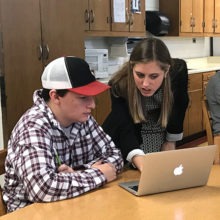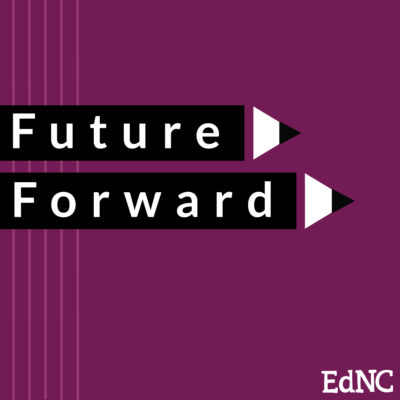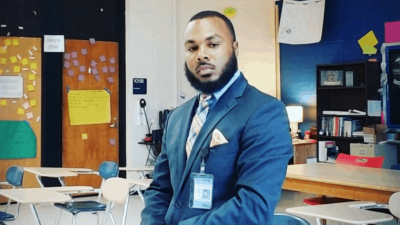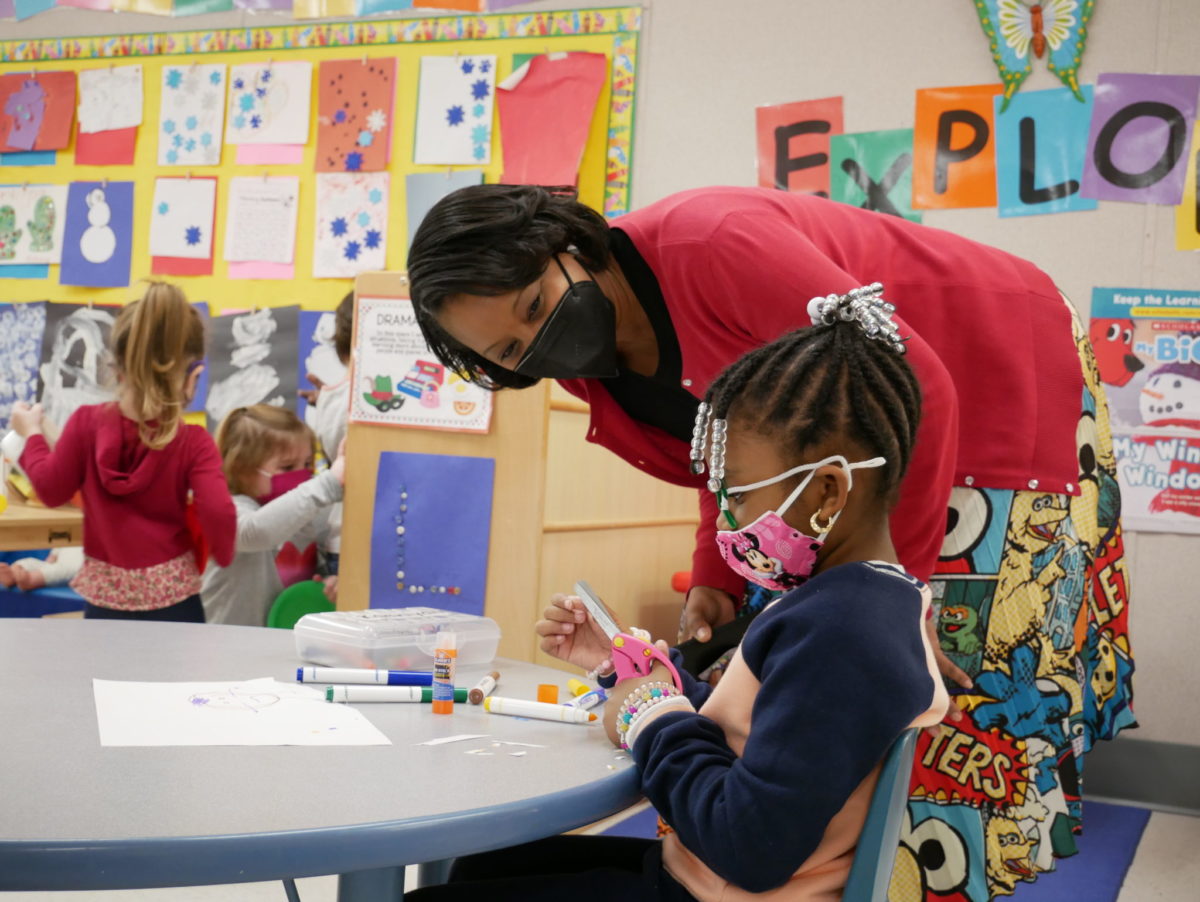
|
|

Lessons from the past school year. Plans for the year ahead. In this special report, EdNC looks at how the pandemic impacted education and what that means for the future. Read the rest of the series here.
Educators, parents, and students have had to reimagine almost every facet of learning in the past year. From early childhood to community college, the COVID-19 pandemic changed school as we knew it.
As the 2020-2021 school year wraps up, EducationNC reflects on how the pandemic has shaped education and what that means for the future in this special report.
We asked you how your year has gone, what’s worked well, and what hasn’t worked well. Over 1,400 educators, parents, and students responded, sharing with us their triumphs and struggles this year.
We spoke to early childhood educators and advocates; K-12 teachers, principals, superintendents, and nutrition directors; community college faculty, staff, and presidents; and state and national education leaders to understand how their lives have changed and what they see ahead.
In part one of this special report, we explore results of our statewide survey of educators, parents, and students. In subsequent parts, we explore lessons learned this year and how those could impact education in the future through an early childhood, K-12, and postsecondary lens.
In addition to our reporting, we also asked several education leaders to share their perspectives. Read the rest of EdNC’s special report and each perspective here.
How did this school year go?
To better understand how COVID-19 impacted education this year, EdNC conducted a survey of educators, parents, and students that ran from March 12 to April 18, 2021.
We asked respondents to rate how the school year went for themselves, for students, for parents, and for educators using a scale of 1-10, with 1 being the lowest score and 10 being the highest. Respondents were more likely to say the school year went better for them individually than for students, parents, or educators overall, even when those responding identified as a student, parent, or educator.
Seventy-five percent of respondents gave their school year a score of 5 or higher. However, when we asked how they thought the school year went for students, parents, and educators, respondents were much more likely to give it a score of 5 or lower.
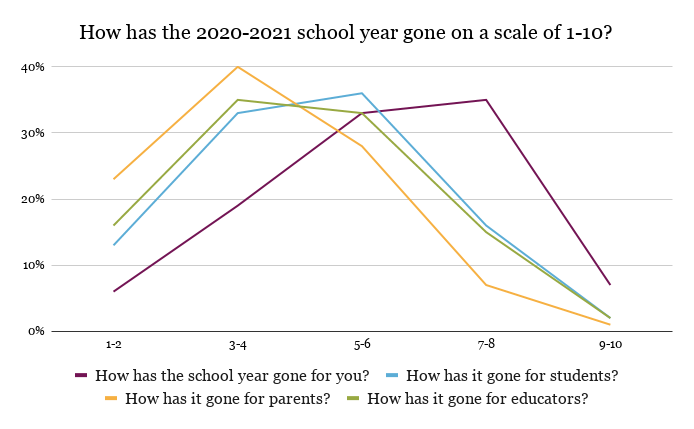
We can break it down further to see responses from the different education groups — K-12, community colleges, early childhood, and parents.
When you break it down into these four groups, you can see that early childhood respondents were more likely to rate their school year a 5 or lower compared to the other groups. Community college respondents, on the other hand, were more likely to rate their school year a 7 or higher compared to the other groups.
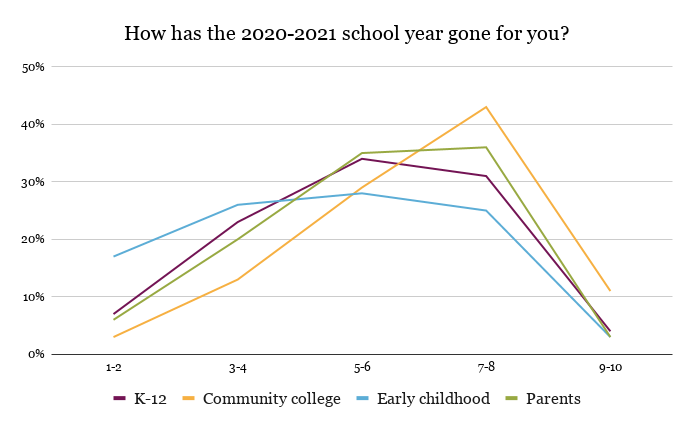
What went well this year?
We asked respondents what went well this year and received 1,129 comments. Below are the major themes along with selected comments.
The use of technology
Educators said one silver lining of the pandemic was the fact that it forced schools and districts to upgrade technology, and it forced teachers to learn how to use it.
“I re-evaluated my teaching methods and greatly improved by skills in the area of technology.”
“My county was so far behind technology wise. I really feel the pandemic has advanced us to current age of technology although it was by demand; it was well needed.”
Both community college and K-12 educators applauded school districts and community colleges for getting devices and hot spots out to students as quickly as possible.
“Our college provided our faculty with the technology, training, and support needed to be able to teach in the synchronous and online formats. Our DE and IT departments were always responsive and quick when I needed help.”
“Schools needed to put new systems in place very rapidly and were able to develop new processes and implement technology at a very rapid pace”.
Many community college educators said the shift to online learning was easier for them because their colleges already offered many classes online. This made the transition easier for teachers and students alike.
“As a community college teacher educator, our students have had positive experiences since our courses were already significantly offered online. To our credit and theirs, online learning was not new to them. This was a significant benefit and lessened the adjustment to 100% remote learning for our college.”
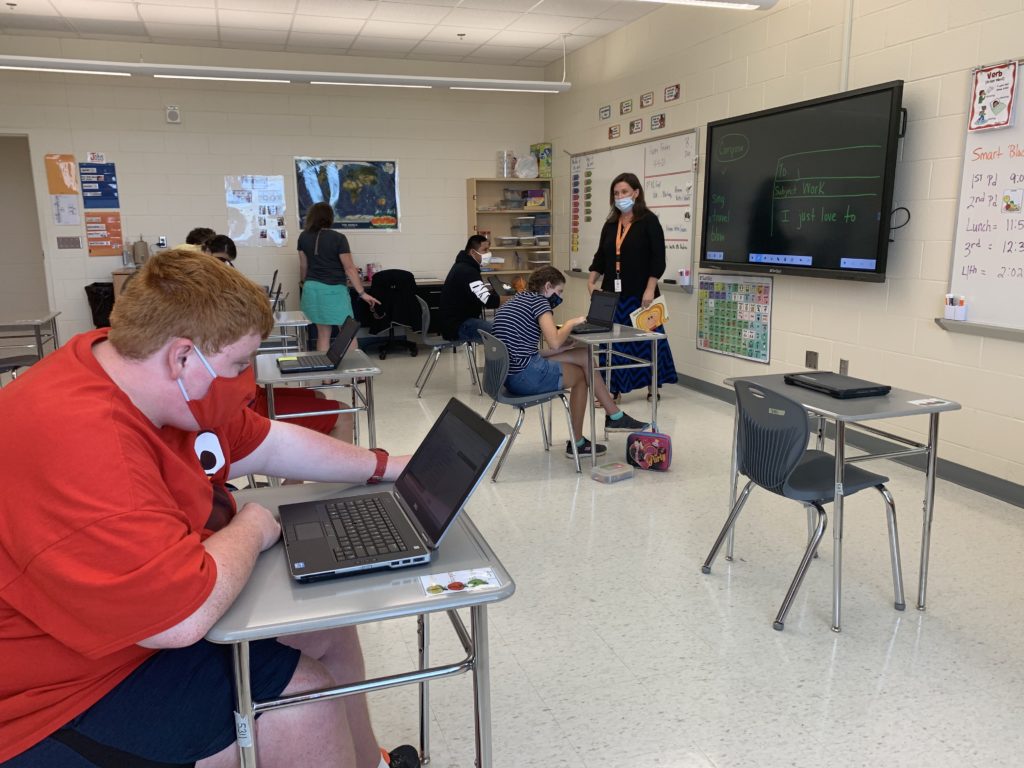
Some students thrived and gained valuable skills during the pandemic
Consistently, we heard from educators and parents this year that some students were doing really well with online learning. In the K-12 setting, teachers shared that highly motivated students who had support at home had more time to devote to projects and learning new skills. Teachers also shared that virtual learning helped students with behavior issues as well as students who struggled with self confidence.
“A lot is said about the students who are not handling remote learning well but there is a large group of students that are excelling during this time. The kids who were bullied in school or who do not have self confidence have really excelled, at least in my opinion. There is also less peer pressure because students are not around each other so some of the behavior issues that students had being around the wrong kids have gone away for now.”
“I have some students who are doing great. They join Zoom, they ask questions, they complete their assignments, and they are learning. They, for the most part, are self-disciplined. They represent about thirty percent of my students. They will not be behind.”
Community college educators shared that online classes, and especially asynchronous classes, increased access for students with jobs, students who are primary caregivers, students without transportation, and more.
“I think there is, for some, a realization that traditional education and classrooms are too limited to meet the needs of multiple students across generations and a variety of life experiences. For some individuals the opening of virtual classrooms has been life altering in a positive way.”
“I’ve had nearly 100% attendance in each of my classes, and those who cannot make it to the session have expressed that the ability to watch the recorded session later has been invaluable to them. I’ve not had any students miss class due to missing the bus, cars breaking down, or loss of childcare – all of which have been legitimate obstacles for them in the past. Many of my students do shift work and are unable to attend classes on campus as a result. Being able to watch the recordings later on the days they have to work has been very well-received and students have embraced this method of instruction as a happy medium between traditional and asynchronous online instruction.”
Across the board, educators said students learned to be more independent and manage their time better.
As a result of the positive experiences for some students, many districts and community colleges are planning to have a fully virtual option next year and in future years.
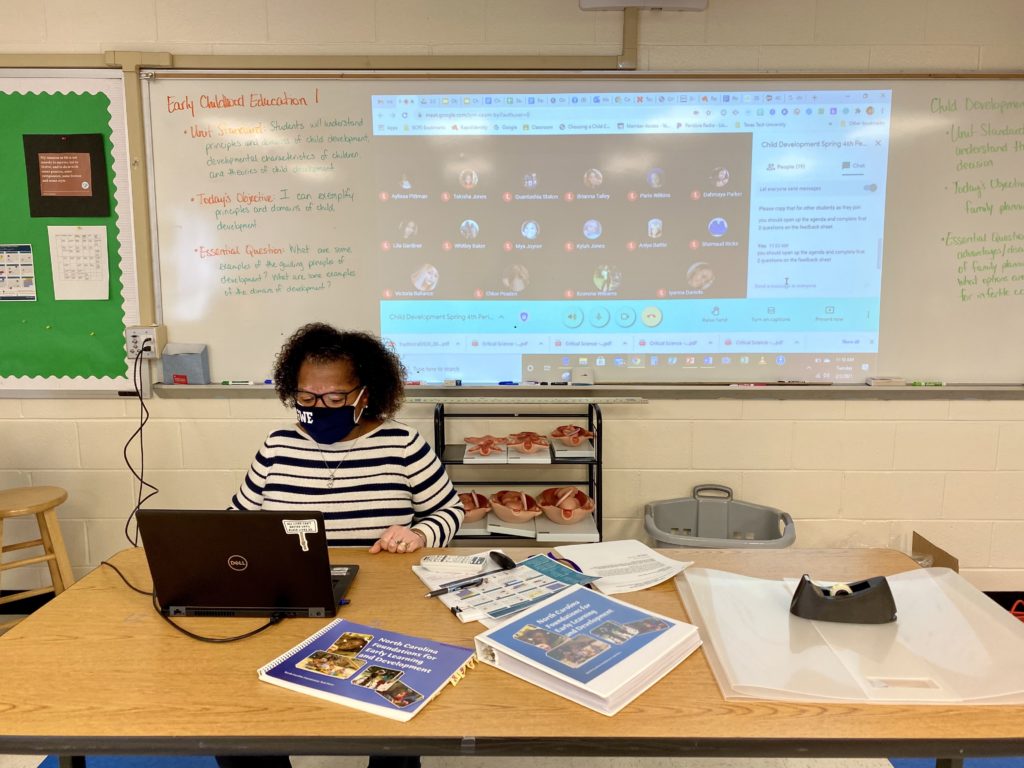
Better collaboration between educators; better communication with parents
As many educators have said, this year made all teachers feel like a first-year teacher again. One benefit of that was increased collaboration between teachers and faculty as everyone learned new techniques and strategies.
“The collaboration amongst colleagues was tremendous.”
“The level of collaboration and sense of team has increased. More teacher are helping each other with best practices, helpful tips, and ideas than ever before.”
Educators and parents also shared that communication between parents and educators improved during the pandemic. While internet access was a challenge for some families, educators said their communication with families increased and some pointed out that parents gained a better understanding of teachers’ roles.
“I feel communication with parents was much better and a parent’s understanding of a teacher’s point-of-view was better.”
“Parent communication has increased in quantity, quality, [and] positivity.”
“Communication with parents and stakeholders has improved dramatically. I think that everyone has had to have patience with each other, and it made us very aware of the limited technology for stakeholders and where our community was lacking services.”
Smaller class sizes, fewer discipline issues
Social distancing requirements this year meant that teachers who had in-person classes inevitably had smaller class sizes. Many teachers said this was beneficial not just for limiting the spread of COVID-19 but also for giving students individualized attention.
“I got to experience what it was like to have a smaller class size and how beneficial it was to student’s learning.”
“I think smaller class sizes [have] been fundamental and essential for trying to get students back on track and caught up with the disruption of COVID 19.”
Several teachers, along with assistant principals and principals, also said they had significantly fewer discipline issues with students this year due to virtual learning and smaller class sizes.
“Small class sizes led to minimal classroom disruption and almost no discipline issues.”
“Our school has had very very few referrals/discipline issues. Therefore, there is a lot of great rapport between teachers and students.”
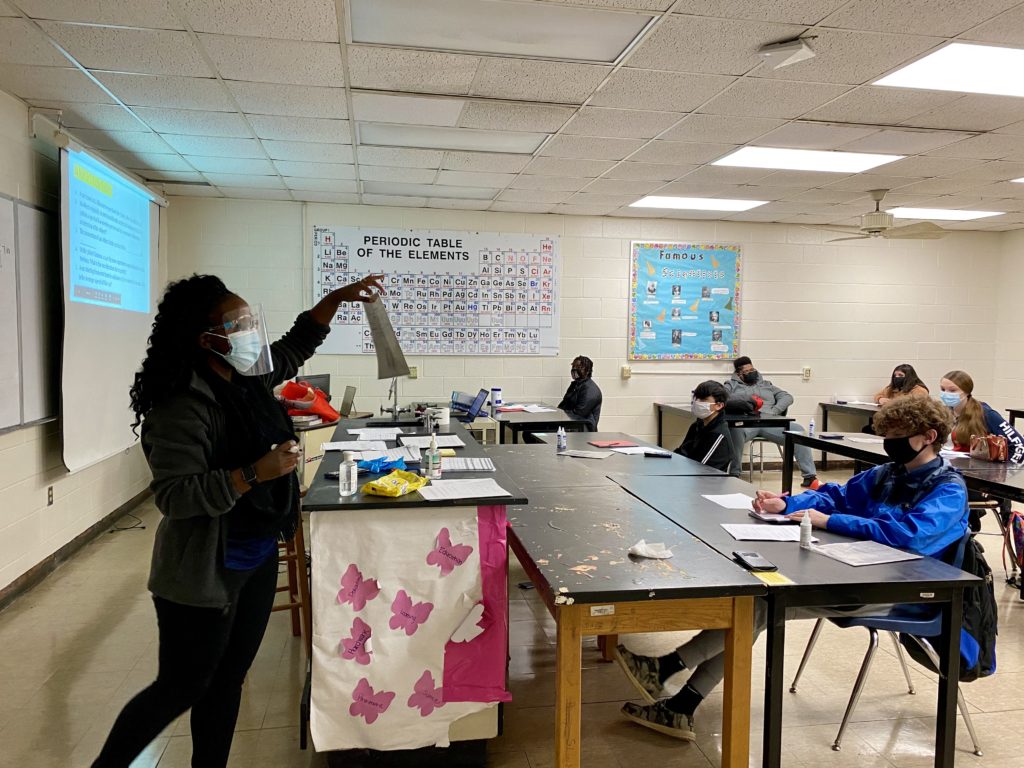
Beneficial structural changes
In addition to smaller class sizes, the pandemic substantially changed many of the typical structures of school as we knew it. Educators and parents want to keep several of these changes in future years, including having one remote day per week, feeding all children free breakfast and lunch, flexible schedules, and later school start times.
“We have had students Mon. to Thurs. with Friday being a remote learning [day]. We have had the chance to do quality planning, deep cleaning, parent meetings, paperwork and closer look at all data on FRIDAYS. This has saved so many interruptions through the week. I have taught in this county for 28 years and this is the first year I have ever felt like I had the time to really have data driven instruction and good parent communication. Please don’t take the Friday remote days. All teachers will just return to ‘survival’ mode.”
“I like the fact that we were able to offer all students free breakfast and lunch. I also like the fact that we used so much less paper in the classrooms because we were forced to do everything electronically. I cannot even imagine how much money that has saved school systems.”
“High school students need flexibility in terms of their classes and scheduling, and many students can handle and manage a flexible academic schedule.”
“Later start times for high schoolers was a blessing. They learn better when they are awake.”
Educators grew, reflected on their practice
Finally, many teachers and faculty members said they have grown as educators during the pandemic. Educators at all levels were proud of the way they adapted and responded to the challenge the pandemic presented.
“I feel teachers have grown in their thinking above and beyond the box! We have had to change our ways and try something(s) new. This has made us better, if we have had our hearts in it.”
“I have learned a lot about online learning and grown tremendously as an educator.”
“We were able to think ‘outside the box’ and adapt to multiple kinds of hardships and STILL teach our students. It was a learning experience for ALL Involved.”
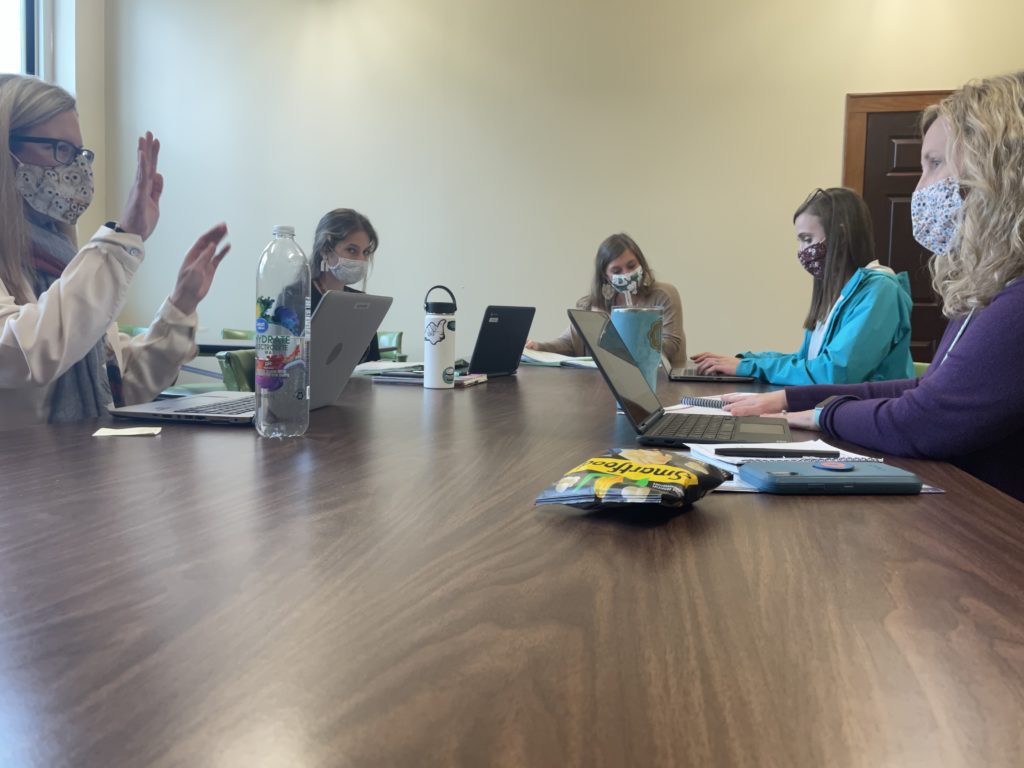
What didn’t go well this year?
We also asked respondents what didn’t go well this year and received 1,096 comments. Below are the major themes along with selected comments.
Remote learning doesn’t work for some students and classes
While some students did well, educators said those without reliable internet, time management skills, and strong support at home suffered during virtual learning.
“We live in a rural area, so internet connectivity and access to devices was a hurdle for many families. Even those who had access would often go ‘off the grid’ for days or weeks at a time.”
“Some students really struggled with the organization and time management of virtual and hybrid and therefore struggled to complete work.”
“I am extremely worried for those students who have no parental support at home, haven’t been to class virtually, and have done no work for most of the school year. It is difficult to engage a family if we can’t find them, contact them, or never see the student. I worry about these students who are falling in the cracks and there seems to be no way out or no known method to catch them up to their grade level peers who are moving on.”
At the community college level, faculty shared that certain classes that require hands-on instruction just don’t work well virtually.
“Many students didn’t even attempt to begin college because they wanted/needed in-person learning. Career Technical Education programs saw a big drop in enrollment because we can’t teach students to weld, change brakes, cut hair, run a water jet, or manage a controlled burn online.”
“In Cosmetology, students need live models, and they had to transition to more [mannequin] work. Interaction with a live client is an important part of hands on training.”
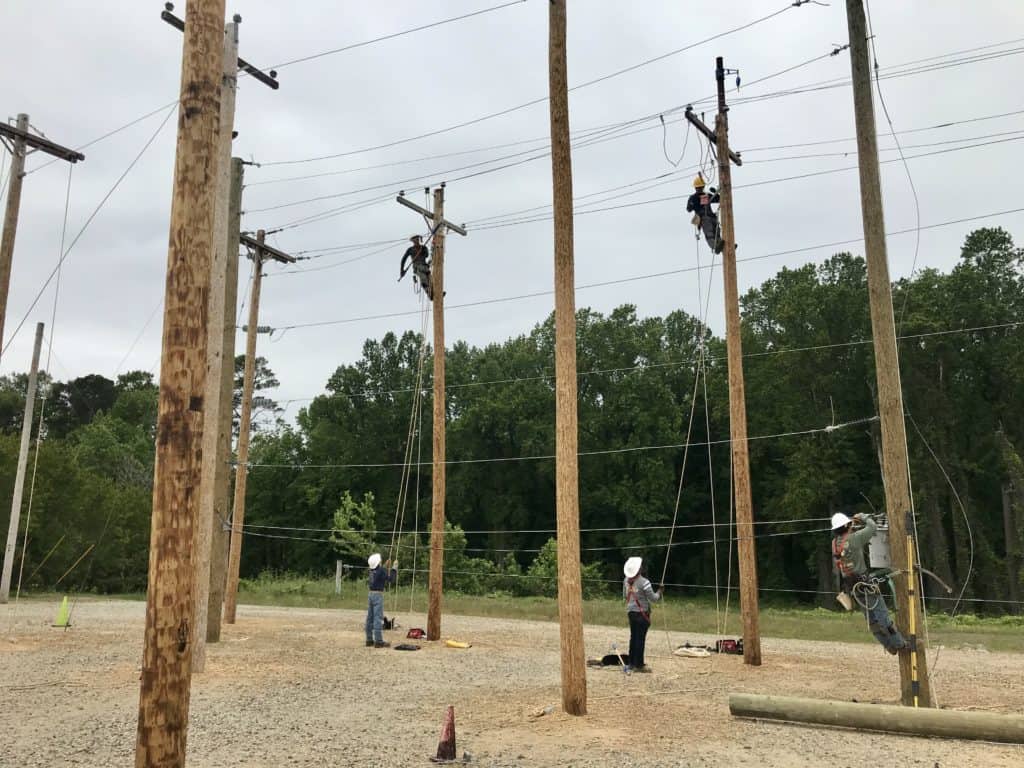
Lack of student engagement
In addition to the challenges outlined above, educators experienced an overall drop in student engagement during virtual learning. Some educators had students who completely checked out and stopped attending virtual classes. Others had difficulty getting students to turn on their cameras and participate during class.
“Student engagement is a challenge. Students have videos off, mics off, and feel pressure to be silent. They have lost their voice in the classroom. It is also very difficult to re-direct students. Students with attention challenges have fallen off. Likewise many students depend on school as a time to build relationships. Without school many children have become extremely isolated and have suffered emotionally.”
“Keeping students engaged is a battle against all distractions: noisy home life or daycares, the ease of [YouTube] and games at their fingertips, students not getting the hands-on learning and in-person time and attention that they need and desire as young learners. Although teachers are doing their very best with what they have, students are not able to learn all they need or have grown a distaste for school.
Teaching virtually and face-to-face at the same time doesn’t work
A common refrain we’ve heard on the road and in the survey is that trying to teach students in the classroom and online at the same time does not work well. Teachers have said they either feel they are leaving one group behind or both groups suffer as they try to work with each.
“The worst is trying to teach in person and virtual students at the same time. It’s a technical nightmare and often feels like working two careers at once. I really hope that hybrid learning won’t continue in the Fall. I honestly don’t know how much more I can personally sustain.”
“Hybrid is terrible. When I have 2/3 of my students on the computer and 1/3 in person, neither group gets my full attention and instruction suffers.”
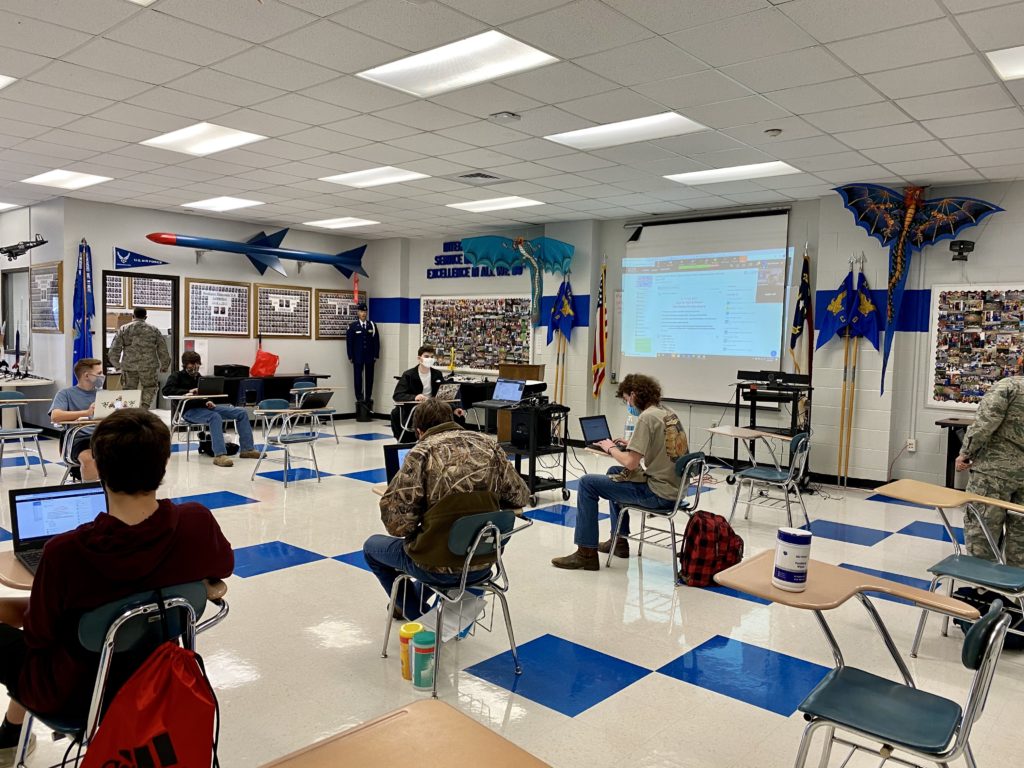
Adapting to schedule changes
Throughout the year, districts shifted between remote, hybrid, and in-person learning as local school boards considered gubernatorial and legislative mandates, COVID-19 case rates, and local comfort levels with in-person learning.
At the beginning of the school year, districts could choose to be either fully remote (plan C) or bring a limited number of students and staff back for in-person instruction (plan B). In September, Gov. Roy Cooper announced that districts could bring elementary students (K-5) back for in-person instruction full time (plan A). Finally, in March, the state legislature passed and Gov. Cooper signed a bill requiring school districts to return students to classrooms either fully in person (plan A) or offer a hybrid of in-person and remote learning (plan B).
Several teachers and parents said schedule changes throughout the year were challenging.
“The constant changes from K-12 in their scheduling for students and the lack of consistency of schedules for students in elementary, middle, and high school within the same district made it very difficult for working parents to figure out how to juggle students learning at home with their own work schedules.”
“School boards constantly changing plans has been a huge obstacle for teachers, students and parents. The inability to make a plan and stick to it has created a great deal of stress and uncertainty. Likewise, schools boards, as political vehicles, have not always kept the interest of all of the stakeholders in mind. They seem to bend to the will of the ‘squeaky wheel’ of the disgruntled voters. Some of their decisions seem to be more based on their desire to please than it is in their knowledge of pedagogy and how buildings run. Their decisions, with very little notice, do not reflect an understanding of how difficult it is to change schedules to accommodate these changes.”
Teacher/faculty increased workload and low morale
Both K-12 and community college educators shared that this year has been incredibly hard on them, both personally and professionally. Many said their workload has doubled as they’ve had to adapt lesson plans, learn new programs, and spend more time reaching out to parents and students.
In addition to the increased workload and health risks of COVID-19, many K-12 teachers said that while teachers were viewed as heroes at the beginning of the pandemic, that public support had since evaporated, resulting in low teacher morale.
“Morale for teachers and admin has been low because we have not felt supported or cared for by our school board or district leadership. We expressed extreme concerns over safety and they were dismissed. This break in trust between those of us in the trenches and the school board is painful and I do not think will get mended soon or quickly.”
“We had a few teachers hospitalized and one even died. It has been really hard on morale for teachers. Parents are also unsympathetic about school work conditions and just want their kids in school. I feel that this has deepened the divide between parents and educators.”
“Lack of support from community and school boards. Decisions made without any teacher input. Out of everyone in the situation, current teachers are the only people who have ever taught remotely, and they have not had any say in decision making.”
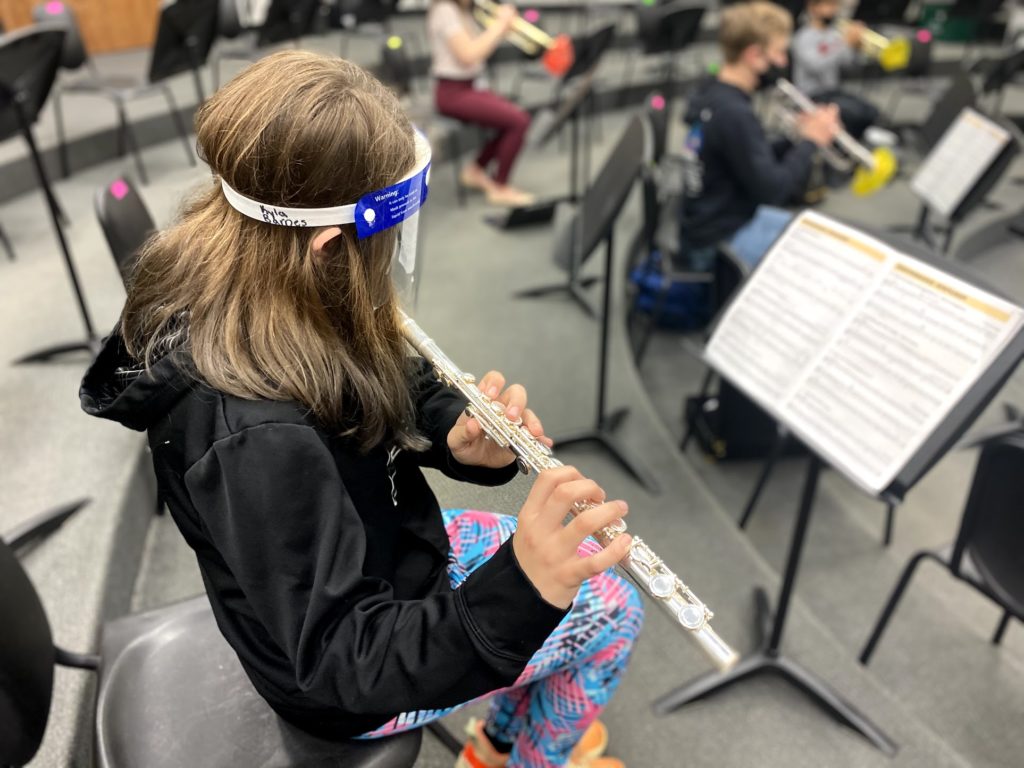
What’s next?
“I think school’s changed forever. And I think if school doesn’t change forever, shame on us,” third grade math teacher Sara Lilley told EdNC’s Alli Lindenberg.
While not every educator, parent, or student wants education to completely change next year, many do not want to go back to exactly the way it was.
We asked respondents if they were hoping for a return to pre-COVID education as it was or something different. Forty-three percent said they hoped for a return to pre-COVID education with a few changes; 28% said they hoped for a return to pre-COVID education with significant changes; 15% said they hoped for a return to pre-COVID education as it was; 11% said they hoped for a completely different educational experience after COVID; and 3% said “I don’t know.”
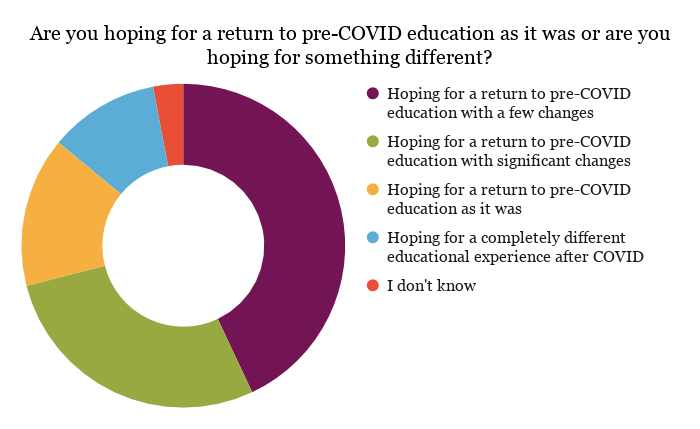
Overall, early childhood educators were more likely to say they wanted a completely different educational experience after COVID. In the comments, several themes came up, including:
- Early childhood teachers need to be paid a living wage and parents need help affording child care.
- Hybrid learning should continue to be an option in higher education.
- Virtual learning should continue to be an option for K-12 students and families.
- The pandemic revealed inequities in our education system that need to be addressed.
Follow along with the rest of EdNC’s special report on this pandemic school year as we look at early childhood, K-12, and postsecondary education and hear from leaders across the education continuum.
EdNC’s survey: Who participated?
Overall, 1,646 individuals responded. Of those participants, 210 did not answer any questions beyond the initial demographic information, leaving the survey with 1,436 reported respondents (partial responses included). These results include only unverified, self-reported data.
We distributed the survey in our newsletters, on our website, and through social media. We asked respondents to tell us their role in North Carolina’s education system. Just over half of respondents said they are K-12 teachers and about a quarter said they are community college faculty or staff. See the breakdown below.
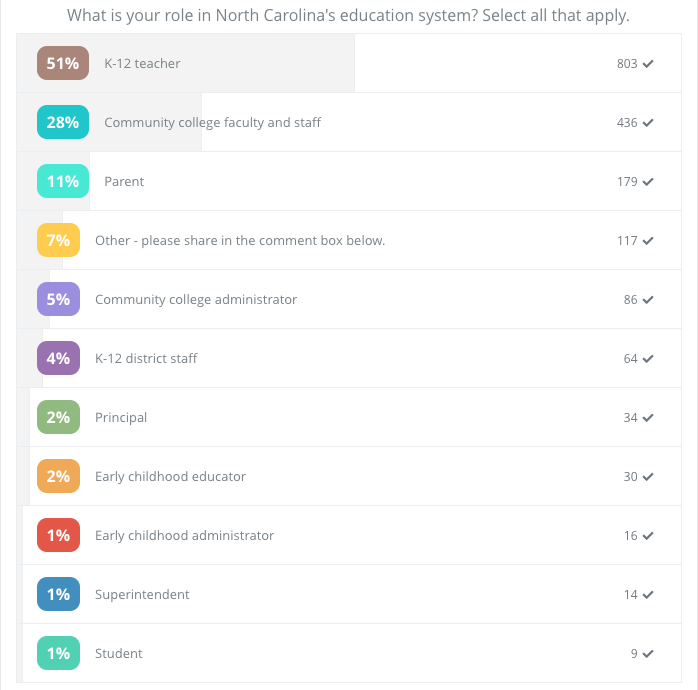
We also asked respondents to tell us where they live and their race/ethnicity. Every county is represented in the survey except Graham and Tyrrell, both of which had no residents respond to the survey. Eight percent of respondents live in Wake County, 5% in Mecklenburg, 4% in Buncombe, and 3% in Cumberland.
About three-quarters (78%) of respondents identified as white; 11% Black or African-American; 2% Hispanic, Latino, or Spanish; 1% American Indian or Alaska Native; 1% Asian; and 1% other. Eight percent preferred not to answer.
